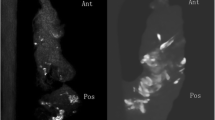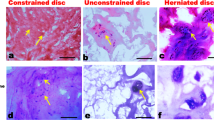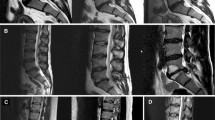Abstract
Purpose
Disc herniations sometimes contain hyaline cartilage fragments, but their origins and significance are uncertain.
Methods
Herniations were removed surgically from 21 patients (aged 35–74 years) whose main symptom was sciatica (10 patients) or back pain (11 patients). Frozen sections, 5 µm thick, were examined histologically, and antibodies were used to label the matrix-degrading enzyme MMP 1, pro-inflammatory mediator TNFα, and cell proliferation marker Ki-67. Proportions of each tissue type were quantified by image analysis. Cartilage and bone components of the endplate were examined in 7-µm frozen sections from 16 cadaveric spines, aged 61–98 years.
Results
Cartilage fragments were found in 10/21 herniations. They averaged 5.0 mm in length, comprised 25 % of the herniation area, and two had some bone attached. Hyaline cartilage was more common in herniations from patients with sciatica (7/10) than with back pain (3/11, P = 0.050), and the area (%) of the herniation occupied by the cartilage was greater in sciatica patients (P < 0.05). Cartilage fragments showed little evidence of swelling, proteoglycan loss or inflammatory cell invasion, although cell clustering was common, and TNFα was sometimes expressed. Each cartilage fragment showed at least one straight edge, as if it had been peeled off the bony endplate, and this mechanism of failure was demonstrated in preliminary mechanical experiments.
Conclusion
Disc herniations often include hyaline cartilage pulled from the vertebral endplates. Cartilage fragments show little swelling or proteoglycan loss, and may be slow to resorb, increasing the risk of persisting sciatica. Loss of cartilage will increase endplate permeability, facilitating endplate inflammation and disc infection.






Similar content being viewed by others
References
Moore RJ, Vernon-Roberts B, Fraser RD, Osti OL, Schembri M (1996) The origin and fate of herniated lumbar intervertebral disc tissue. Spine 21:2149–2155
Willburger RE, Ehiosun UK, Kuhnen C, Kramer J, Schmid G (2004) Clinical symptoms in lumbar disc herniations and their correlation to the histological composition of the extruded disc material. Spine 29:1655–1661
Rajasekaran S, Bajaj N, Tubaki V, Kanna RM, Shetty AP (2013) ISSLS prize winner: The anatomy of failure in lumbar disc herniation: an in vivo, multimodal, prospective study of 181 subjects. Spine 38:1491–1500
Dolan P, Adams MA, Hutton WC (1987) The short-term effects of chymopapain on intervertebral discs. J Bone Joint Surg [Br] 69:422–428
Autio RA, Karppinen J, Niinimaki J, Ojala R, Kurunlahti M et al (2006) Determinants of spontaneous resorption of intervertebral disc herniations. Spine 31:1247–1252
Lama P, Le Maitre CL, Dolan P, Tarlton JF, Harding IJ et al (2013) Do intervertebral discs degenerate before they herniate, or after? Bone Joint J 95-B:1127–1133
Summers GC, Merrill A, Sharif M, Adams MA (2008) Swelling of articular cartilage depends on the integrity of adjacent cartilage and bone. Biorheology 45:365–374
Fields AJ, Liebenberg EC, Lotz JC (2014) Innervation of pathologies in the lumbar vertebral end plate and intervertebral disc. Spine J 14(3):513–521
Fagan A, Moore R, Vernon Roberts B, Blumbergs P, Fraser R (2003) ISSLS prize winner: The innervation of the intervertebral disc: a quantitative analysis. Spine 28:2570–2576
Peng B, Chen J, Kuang Z, Li D, Pang X et al (2009) Diagnosis and surgical treatment of back pain originating from endplate. Eur Spine J 18:1035–1040
Kuslich SD, Ulstrom CL, Michael CJ (1991) The tissue origin of low back pain and sciatica: a report of pain response to tissue stimulation during operations on the lumbar spine using local anesthesia. Orthop Clin North Am 22:181–187
Wang Y, Videman T, Battie MC (2012) Lumbar vertebral endplate lesions: prevalence, classification, and association with age. Spine 37:1432–1439
Wang Y, Videman T, Battie MC (2012) ISSLS prize winner: Lumbar vertebral endplate lesions: associations with disc degeneration and back pain history. Spine 37:1490–1496
Rodriguez AG, Slichter CK, Acosta FL, Rodriguez-Soto AE, Burghardt AJ et al (2011) Human disc nucleus properties and vertebral endplate permeability. Spine 36:512–520
Albert HB, Lambert P, Rollason J, Sorensen JS, Worthington T et al (2013) Does nuclear tissue infected with bacteria following disc herniations lead to Modic changes in the adjacent vertebrae? Eur Spine J 22:690–696
Zhao F, Pollintine P, Hole BD, Dolan P, Adams MA (2005) Discogenic origins of spinal instability. Spine 30:2621–2630
Adams MA, Freeman BJ, Morrison HP, Nelson IW, Dolan P (2000) Mechanical initiation of intervertebral disc degeneration. Spine 25:1625–1636
Kato T, Haro H, Komori H, Shinomiya K (2004) Sequential dynamics of inflammatory cytokine, angiogenesis inducing factor and matrix degrading enzymes during spontaneous resorption of the herniated disc. J Orthop Res 22:895–900
Weiler C, Nerlich AG, Zipperer J, Bachmeier BE, Boos N (2002) 2002 SSE Award Competition in Basic Science: expression of major matrix metalloproteinases is associated with intervertebral disc degradation and resorption. Eur Spine J 11:308–320
Skrzypiec D, Tarala M, Pollintine P, Dolan P, Adams MA (2007) When are intervertebral discs stronger than their adjacent vertebrae? Spine 32:2455–2461
Fields AJ, Lee GL, Keaveny TM (2010) Mechanisms of initial endplate failure in the human vertebral body. J Biomech 43:3126–3131
Eckert C, Decker A (1947) Pathological studies of intervertebral discs. J Bone Joint Surg Am 29:447–454
Harada Y, Nakahara S (1989) A pathologic study of lumbar disc herniation in the elderly. Spine 14:1020–1024
Shan Z, Fan S, Xie Q, Suyou L, Liu J, et al. (2014) Spontaneous resorption of lumbar disc herniation is less likely when Modic changes are present. Spine 39(9):736–744
Tanaka M, Nakahara S, Inoue H (1993) A pathologic study of discs in the elderly. Separation between the cartilaginous endplate and the vertebral body. Spine 18:1456–1462
Green TP, Adams MA, Dolan P (1993) Tensile properties of the annulus fibrosus II. Ultimate tensile strength and fatigue life. Eur Spine J 2:209–214
Adams MA, Green TP (1993) Tensile properties of the annulus fibrosus. I. The contribution of fibre-matrix interactions to tensile stiffness and strength. Eur Spine J 2:203–208
Wade KR, Robertson PA, Broom ND (2011) A fresh look at the nucleus-endplate region: new evidence for significant structural integration. Eur Spine J 20:1225–1232
Adams MA, McNally DS, Chinn H, Dolan P (1994) Posture and the compressive strength of the lumbar spine. Clin Biomech 9:5–14
Adams MA, McNally DS, Dolan P (1996) ‘Stress’ distributions inside intervertebral discs. The effects of age and degeneration. J Bone Joint Surg Br 78:965–972
Dolan P, Earley M, Adams MA (1994) Bending and compressive stresses acting on the lumbar spine during lifting activities. J Biomech 27:1237–1248
Adams MA, Green TP, Dolan P (1994) The strength in anterior bending of lumbar intervertebral discs. Spine 19:2197–2203
Moon SM, Yoder JH, Wright AC, Smith LJ, Vresilovic EJ, et al. (2013) Evaluation of intervertebral disc cartilaginous endplate structure using magnetic resonance imaging. Eur Spine J 22:1820–1828
Rodrigues SA, Wade KR, Thambyah A, Broom ND (2012) Micromechanics of annulus-end plate integration in the intervertebral disc. Spine J 12:143–150
Adams MA, Hutton WC (1982) Prolapsed intervertebral disc. A hyperflexion injury 1981 Volvo Award in Basic Science. Spine 7:184–191
Hollander AP, Heathfield TF, Webber C, Iwata Y, Bourne R et al (1994) Increased damage to type II collagen in osteoarthritic articular cartilage detected by a new immunoassay. J Clin Invest 93:1722–1732
Urban JPG, Maroudas A (1981) Swelling of the intervertebral disc in vitro. Connect Tissue Res 9:1–10
Johnson WE, Caterson B, Eisenstein SM, Roberts S (2005) Human intervertebral disc aggrecan inhibits endothelial cell adhesion and cell migration in vitro. Spine 30:1139–1147
Johnson WE, Caterson B, Eisenstein SM, Hynds DL, Snow DM et al (2002) Human intervertebral disc aggrecan inhibits nerve growth in vitro. Arthritis Rheum 46:2658–2664
Rodriguez AG, Rodriguez-Soto AE, Burghardt AJ, Berven S, Majumdar S et al (2012) Morphology of the human vertebral endplate. J Orthop Res 30:280–287
Albert HB, Manniche C (2007) Modic changes following lumbar disc herniation. Eur Spine J 16:977–982
Albert HB, Sorensen JS, Christensen BS, Manniche C (2013) Antibiotic treatment in patients with chronic low back pain and vertebral bone edema (Modic type 1 changes): a double-blind randomized clinical controlled trial of efficacy. Eur Spine J 22:697–707
Acknowledgments
This work was funded in the U.K. by BackCare, and by a scholarship from the State Government of Sikkim, India.
Conflict of interest
All authors have no conflict of interest.
Ethical standard
Research approved by the NRes Ethics Committee, Frenchay Hospital, Bristol, UK.
Author information
Authors and Affiliations
Corresponding author
Rights and permissions
About this article
Cite this article
Lama, P., Zehra, U., Balkovec, C. et al. Significance of cartilage endplate within herniated disc tissue. Eur Spine J 23, 1869–1877 (2014). https://doi.org/10.1007/s00586-014-3399-3
Received:
Revised:
Accepted:
Published:
Issue Date:
DOI: https://doi.org/10.1007/s00586-014-3399-3




